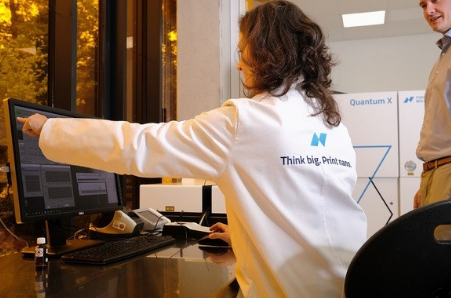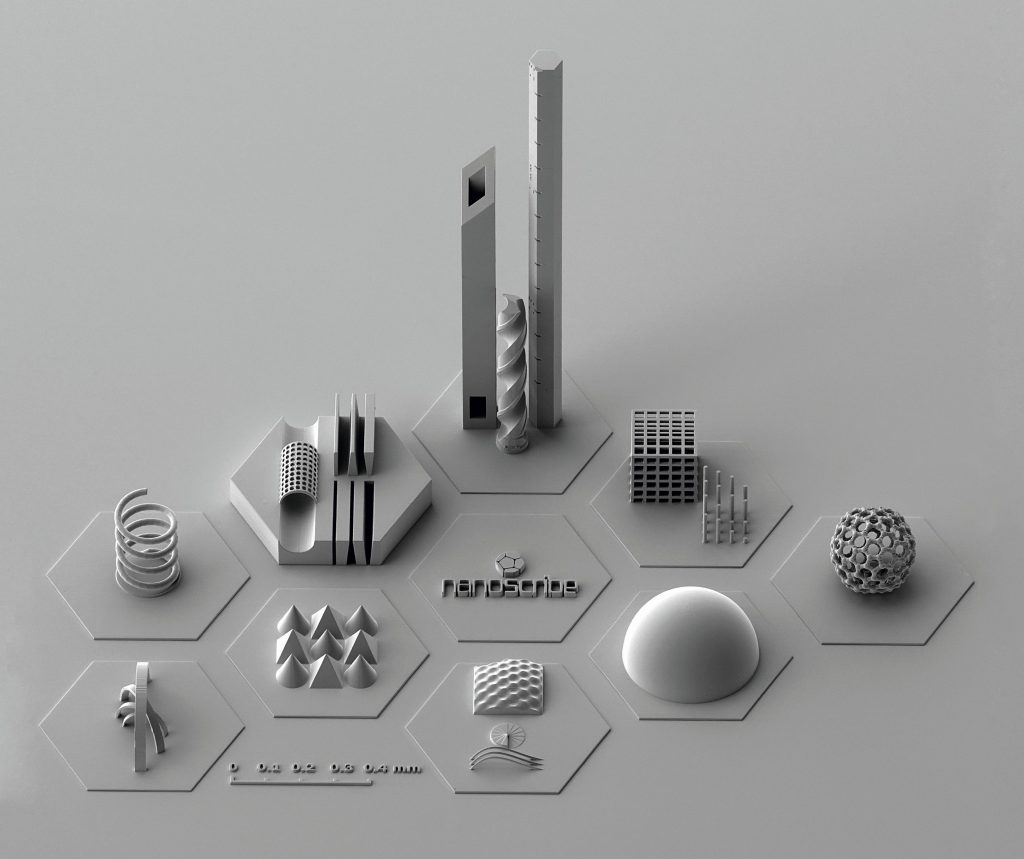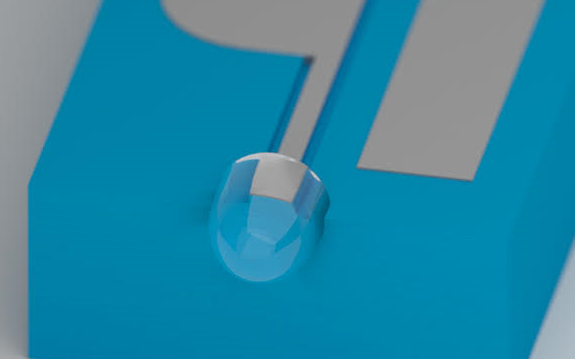Nanoscribe Opens Micro 3D Printing Experience Center
German 3D printer manufacturer and microfabrication specialist Nanoscribe has just announced the opening of their Microfabrication Experience Center. Centered at company headquarters in the ZEISS Innovation Hub at the gates of Campus North of the Karlsruhe Institute of Technology (KIT), the new facility is set up for events involving as many as 100 people, and houses high-performance technology like the Photonic Professional GT2 and a Quantum X maskless lithography system.
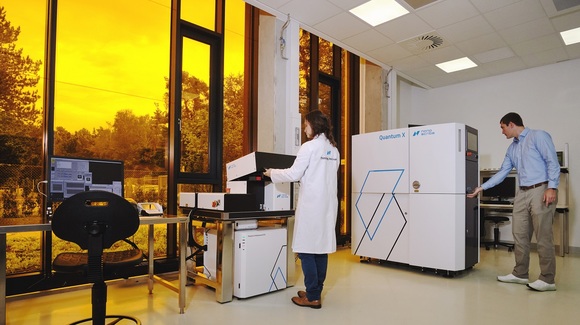
The Microfabrication Experience Center features a spacious laboratory, exhibition, and conference rooms for product demonstrations, feasibility testing, and training as well as workshops covering the entire spectrum of 3D Microfabrication.
Open to customers, business partners, experts in AM processes, and other users and stakeholders, this new center will offer a site for comprehensive testing and validation of the potential for a range of applications—along with offering programs for improving 3D printing skills.
Known for nano-, micro-, and mesoscale production, Nanoscribe will also allow interested parties to meet with their experts to explore topics in microfabrication. They plan to customize visits for customers and others, depending on their technology interests, offering the following:
- Individualized product demonstrations
- Feasibility demonstrations
- Training courses for new and experienced users to learn how to use Nanoscribe technology
- Expert workshops
- User meetings
Upon individual consultations with Nanoscribe engineers and sales consultants, product demonstrations will be available, giving customers a glimpse into the potential for additive manufacturing within their own companies using Nanoscribe’s 3D Microfabrication technology based on Two-Photon Polymerization (2PP) and Two-Photon Grayscale Lithography (2GL®).
Networking possibilities should also abound as customers, partners, and others meet at the facility to cover discussions regarding new trends in the 3D printing industry, challenges, and more—all centering around prototyping, printing, mastering, and replication.
While many customers will benefit from being able to see and use Nanoscribe hardware and software in person, plenty of other digital events will also be available and broadcast online live from the Microfabrication Experience Center, to include:
- Customer visits
- Product demonstrations
- Training
- Webinars
- Workshops
The Nanoscribe team will be offering instructional exhibits and a variety of other programs from the Demolab, conference room, and showroom.
“We aim to inspire our customers and enable them to materialize their groundbreaking ideas and innovations with our 3D Microfabrication technology,” states Martin Hermatschweiler, CEO and co-founder of Nanoscribe.
“The new Microfabrication Experience Center is therefore important to validate the suitability of our technology for customers’ projects and to intensify partnerships. As a reliable partner in 3D Microfabrication we provide collaboration, problem solving and training options.”
Nanoscribe continues to be one of the most dynamic leaders in additive manufacturing, involved in countless projects, from combining micro-technology with conventional methods to offering materials for life-science applications, fabricating innovative medical devices like cochlear implants, and more.
[Source / Images: Nanoscribe]
The post Nanoscribe Opens Micro 3D Printing Experience Center appeared first on 3DPrint.com | The Voice of 3D Printing / Additive Manufacturing.
European partners set to develop handheld eye scanner containing 3D printed optics
Nanoscribe’s New Printing Material for Life Science Applications
 At one of the world’s leading photonics, laser, and biomedical optics conference taking place right now in San Fransisco, California, the SPIE BiOS and Photonics West conference, German-based two-photon polymerization technology company Nanoscribe, has announced the release of its latest new printing material that can turn innovations on the microscale into biocompatible products. Known as IP-Visio, the development was designed to print filigree and low-fluorescent 3D microarchitectures for tissue engineering.
At one of the world’s leading photonics, laser, and biomedical optics conference taking place right now in San Fransisco, California, the SPIE BiOS and Photonics West conference, German-based two-photon polymerization technology company Nanoscribe, has announced the release of its latest new printing material that can turn innovations on the microscale into biocompatible products. Known as IP-Visio, the development was designed to print filigree and low-fluorescent 3D microarchitectures for tissue engineering.
A spin-off of the Karlsruhe Institute of Technology (KIT), Nanoscribe develops and provides 3D printers for the nano, micro, and mesoscale, along with photoresists and process solutions. Rallying up the slogan: “We make small things matter,” company founders managed to develop a technology that can 3D print products crucial for smartphones, handheld devices and in the field of medical technology. Making two-photon polymerization (2PP) based 3D printers commercially available they have already offered solutions to universities and pioneering industries worldwide, working on 3D microprinting life sciences studies, as well as 3D printing optics at the nanoscale, and even using their technology to develop innovative devices like the 3D-microscaffold cochlear implant for steroid elution.

Biocompatible 3D microstructure fabricated with Nanoscribe’s printing technology (Credit: Nanoscribe)
According to Nanoscribe, 2D cell culture systems have been standard for the past century, enabling findings in many applications, ranging from stem cell research, drug screening, and regenerative medicine. However, cells interact with neighboring cells, the extracellular matrix, and surrounding molecules in 3D. Cells in vivo experience an extremely complex three-dimensional environment at the organ, tissue and cellular level down and below the micrometer scale. Nanoscribe’s 3D microfabrication has demonstrated how this technology enables the fabrication of intricate 3D microstructures such as 3D cell scaffolds. With IP-Visio, the company takes a step further in the fabrication of biocompatible 3D microstructures.
The new Nanoscribe printing material is non-cytotoxic according to ISO 10993-5, the biological evaluation of medical devices that test for in vitro cytotoxicity. This makes IP-Visio suitable for cell-friendly 3D scaffolds. The company claims that with this material, high-precision microstructures can be fabricated to mimic realistic and high-precision microenvironments.
Moreover, IP-Visio shows very low autofluorescence, which as stated by Nanoscribe, means this property allows a clear view through the printed scaffolds, whereby scientists can analyze cellular components and processes by means of fluorescence microscopy without the interference of the printed structures.
After 10 years of being on the market, Nanoscribe has helped customers become pioneers and innovation leaders in science and industry, for example, producing DOEs, micro-optics as well as photonic wire bonds for ICT. And with more than 1,000 users in 30 countries, their new IP-Visio is sure to draw a lot of attention.
At both the SPIE BiOS booth number 8256 and Photonics West booth 3254 at hall E, Nanoscribe will present their new product that enables microfabrication in biocompatible quality, as well as numerous exhibits of their 3D microfabrication technology and what it can be used for: from high precision 3D microparts to millimeter-scale mechanical components and biocompatible structures for life science applications. Moreover, they will demonstrate innovative application samples of optical quality made possible by the new maskless lithography system Nanoscribe Quantum X, including microlens arrays and diffractive optical elements.
The post Nanoscribe’s New Printing Material for Life Science Applications appeared first on 3DPrint.com | The Voice of 3D Printing / Additive Manufacturing.
Maskless Microfabrication: Nanoscribe Releases Quantum X
Germany-headquartered Nanoscribe has just announced the formal release of their Quantum X device, presenting the new technology at the LASER World of Photonics in Munich (running from June 24-27). Continuing in their mission to target industrial users engaged in microfabrication endeavors, this launch expands on their additive manufacturing systems for nano- and microscale projects.
 The Nanoscribe development team created Quantum X specifically for highly-precise micro-optics, offering a powerful combination with grayscale lithography and two-photon polymerization technology.
The Nanoscribe development team created Quantum X specifically for highly-precise micro-optics, offering a powerful combination with grayscale lithography and two-photon polymerization technology.
“Quantum X provides a more flexible, straightforward and cost-effective maskless lithography solution for various use cases,” reports Nanoscribe in their latest press release sent to 3DPrint.com. “Within its compact housing, prototypes of refractive and diffractive microoptics, as well as, polymer masters are produced. The system features an industrial form factor with intuitive and ready-to-use interfaces for process control.”
Nanoscribe created this new technology in response to the high demand for manufacturing in applications like:
- Sensors
- Mobile devices
- Data
- Telecommunications
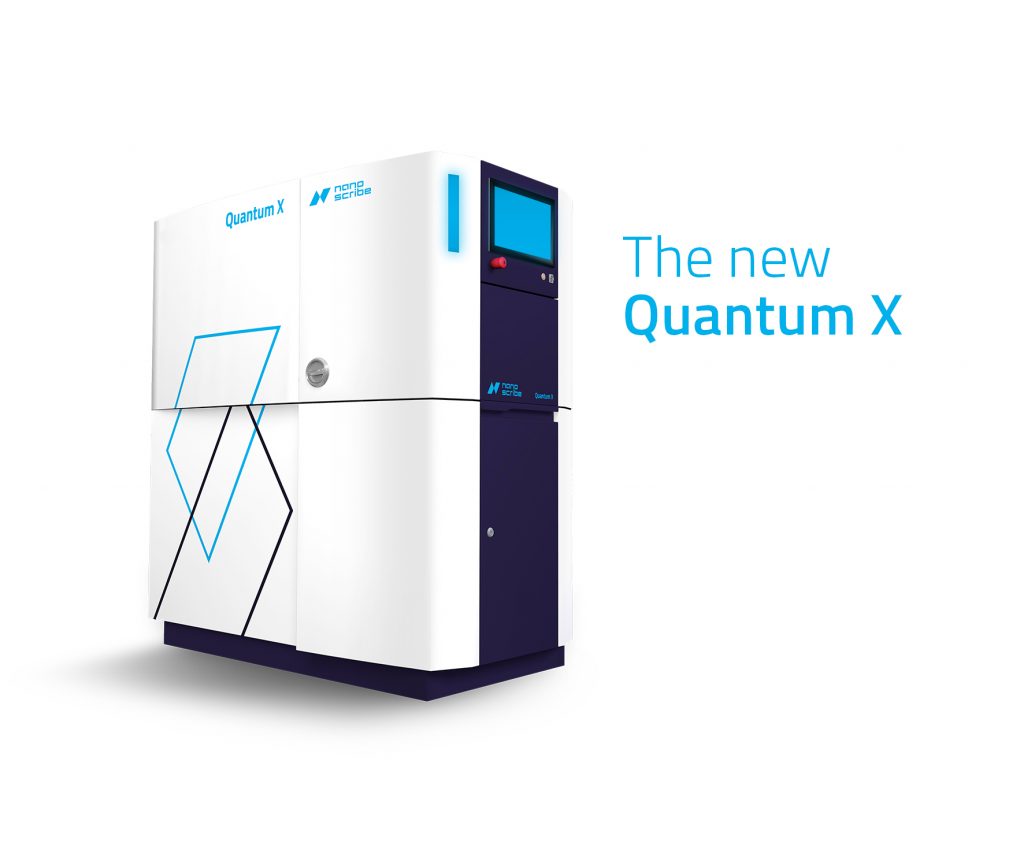
Quantum X is Nanoscribe’s new maskless lithography system for the fabrication of refractive and diffractive micro-optics with the highest precision.
Microfabrication work can be completed quickly and accurately, relying on three cameras for live monitoring and process control. Users can look forward to benefits like faster development, shorter design iteration cycles, greater affordability, rapid production, and a more expedient printing process overall. Nearly any 2.5D shape can be created on the microscale, a feat Nanoscribe states was previously impossible, now ‘paving the way to new or strongly enhanced optical elements from imaging, illumination, to sensing.’
Multilevel diffractive optical elements (DOE) are produced in one scanning plane, as laser power is modulated—resulting in excellent contouring capabilities for more efficient fabrication of:
- Single optical elements
- Spherical and aspherical lenses
- Arrays with high fill factors up to 100 percent
“Quantum X developers have put great effort to excel in advanced user-machine interactions,” states the Nanoscribe team.
A touchscreen is built-in for monitoring jobs, adjusting parameters, and seeing the print in real time—along with a software wizard that guides users through the entire cycle of a print job. The software will accept images of optical designs up to 32-bit resolution like BMP, PNG, or TIFF. A wide range of feature heights are possible in each scan field, and quasi-continuous topographies can be manufactured in one step. The AM approach allows users to expand beyond traditional limitations in height, throughput, and resolution.
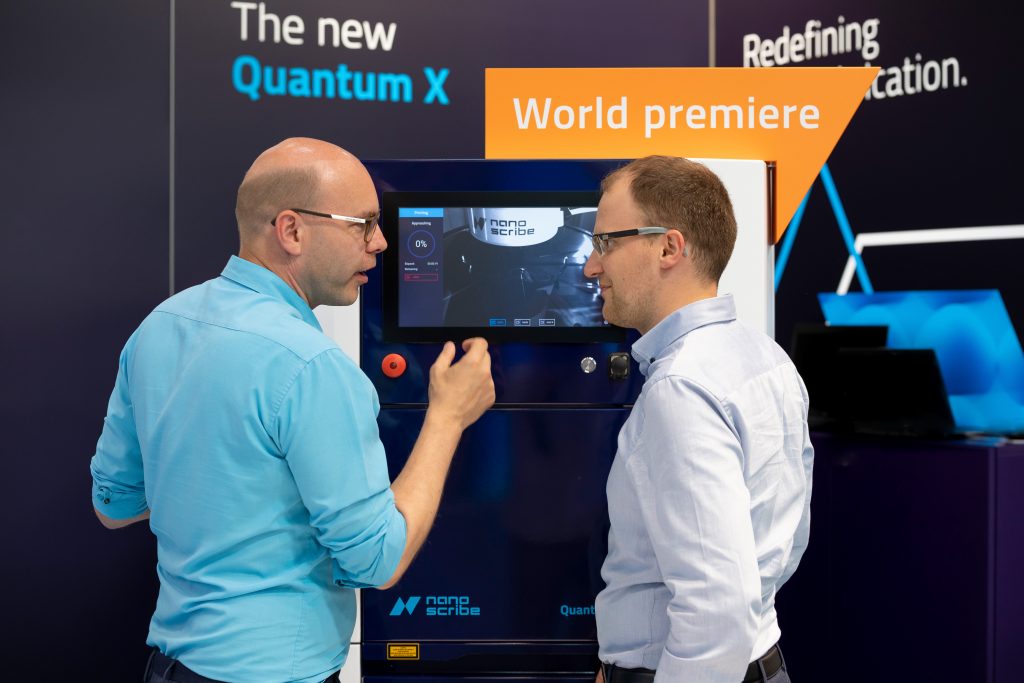
Quantum X intuitive touchscreen panel offers process control, job status and print job queue. (Photo: Chris Frühe)
“The fabrication process with Quantum X allows a wide range of substrates, including transparent and opaque ones, accepting sizes of up to six-inch wafers. Working with this new device avoids costly mask fabrication, spin-coating, and pre- or post-baking when used with Nanoscribe photoresins. These resin materials are easy to handle, allow high aspect ratios and enable high structures, approaching the limits of the physically possible,” states Nanoscribe.
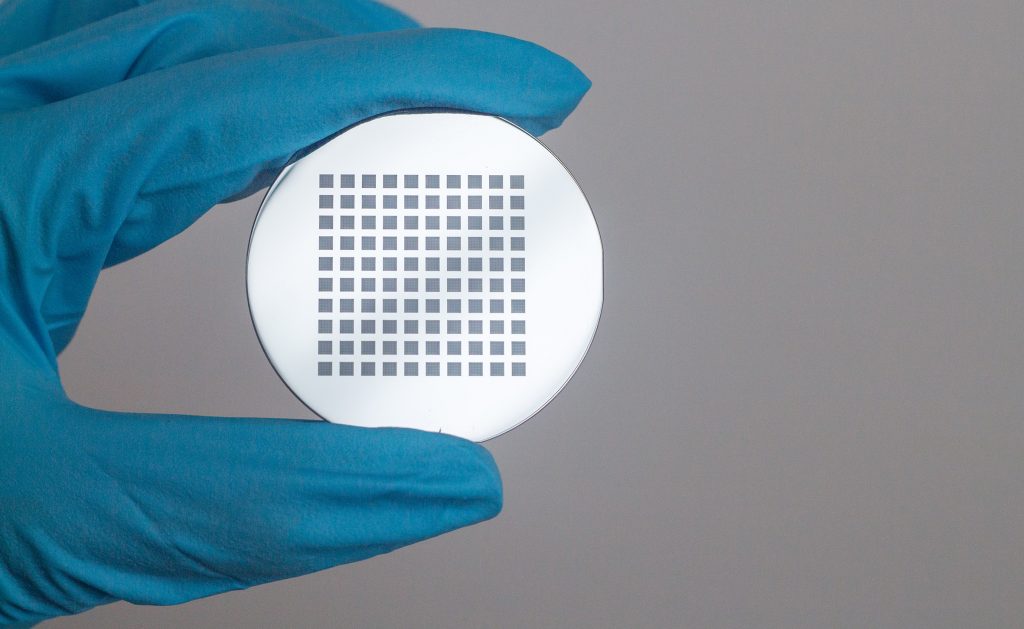
Micro-optics directly printed on a two-inch wafer without the need for additional lithography steps or mask fabrication.
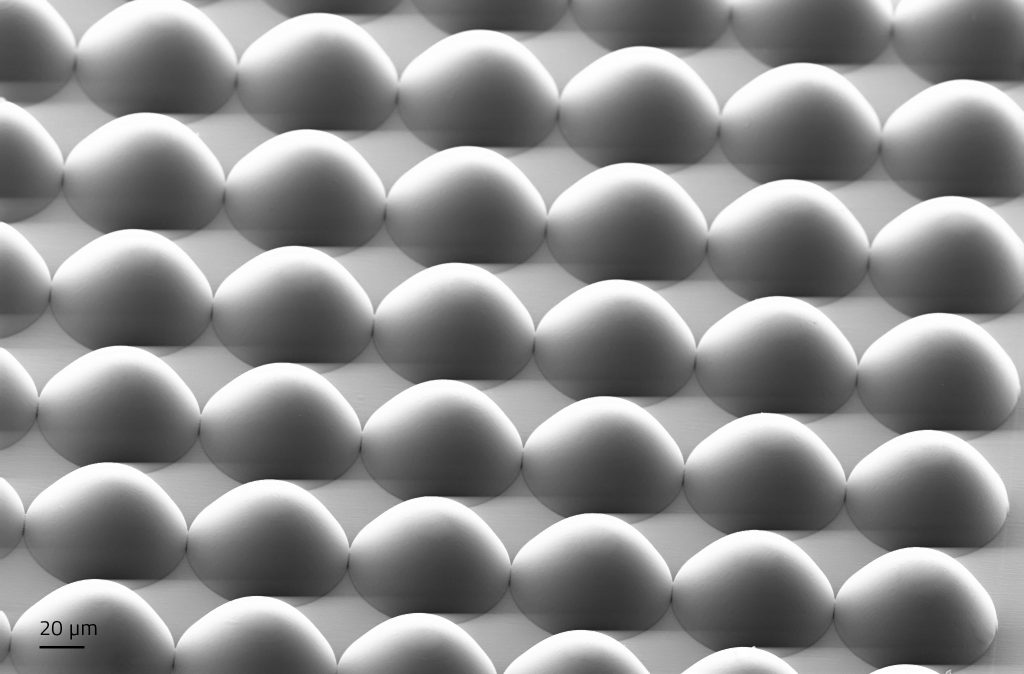
Micro-optics directly printed on a two-inch wafer without the need for additional lithography steps or mask fabrication.
Nanoscribe has been a dynamic presence in the world of printing and microfabrication for years, growing with one innovation after another—from extensive collaborations to a variety of different technologies and processes. What do you think of this news? Let us know your thoughts! Join the discussion of this and other 3D printing topics at 3DPrintBoard.com.
[Source / Images: Nanoscribe]
3D Printing News Briefs: June 25, 2019
Recently, HP released its sustainable impact report for 2018, which is the first item we’ll tell you about in our 3D Printing News Briefs. Then it’s on to more good news – the 3D Factory Incubator in Barcelona is reporting a very positive first 100 days in business, while AMUG has named the winners from its Technical Competition. We’ll close with some metal 3D printing – Nanoscribe published a fly-over video that illustrates the design freedom of nano- and microscale 3D printing, and Laser Lines is now a UK reseller for Xact Metal.
HP Releases 2018 Sustainable Impact Report

HP recycling bottle shred: Through its recycling programs, HP is transforming how we design, deliver, recover, repair, and reuse our products and solutions for a circular future.
HP has released its Sustainable Impact Report for 2018, which talks about the company’s latest advancements in achieving more sustainable impact across its business, as well as the communities it serves, in order to create a better green future. Its sustainability programs drove over $900 million in new revenue last year, and the report shows how HP is using 3D printing to drive a sustainable industrial revolution, such as reducing the amount of materials it uses and expanding its recycling program. The report also states new commitments the company set for itself in order to drive a low-carbon, circular economy.
“Companies have critically important roles to play in solving societal challenges, and we continue to reinvent HP to meet the needs of our changing world. This isn’t a nice to do, it’s a business imperative,” explained Dion Weisler, the President and CEO of HP Inc. “Brands that lead with purpose and stand for more than the products they sell will create the most value for customers, shareholders and society as a whole. Together with our partners, we will build on our progress and find innovative new ways to turn the challenges of today into the opportunities of tomorrow.”
To learn more about HP’s efforts to reduce the carbon footprint, such as investing in an initiative to keep post-consumer plastic from entering our waterways and the recycling program it started with new partner SmileDirectClub, visit the company’s dedicated Sustainable Impact website.
Successful First 100 Days at 3D Factory Incubator
 On February 11th, 2019, 3D Factory Incubator – the first European incubator of 3D printing – was officially inaugurated in Barcelona. It’s now been over 100 days since the launch, and things are going very well. In that time period, the incubator is reporting a total of 15,000 3D printed pieces, and 20 incubated companies, and still has room for more interested projects, though all its private spaces are now occupied. The original goal is to incubate 100 companies in 5 years, and it seems as if 3D Factory Incubator is well on its way.
On February 11th, 2019, 3D Factory Incubator – the first European incubator of 3D printing – was officially inaugurated in Barcelona. It’s now been over 100 days since the launch, and things are going very well. In that time period, the incubator is reporting a total of 15,000 3D printed pieces, and 20 incubated companies, and still has room for more interested projects, though all its private spaces are now occupied. The original goal is to incubate 100 companies in 5 years, and it seems as if 3D Factory Incubator is well on its way.
Located in the Zona Franca Industrial Estate, the unique initiative is led by El Consorci de Zona Franca de Barcelona (CZFB) and the Fundación LEITAT, and has received an investment of €3 million. The goal of the incubator is promote the growth of 3D printing initiatives, and there are a wide variety of companies hosted there, including consumer goods, a logistics company, healthcare companies, design initiatives, and mobility.
AMUG Technical Competition Winners Announced

(top) Erika Berg’s digitally printed helmet liner components and Riddell’s SpeedFlex Precision Diamond Helmet; (left) Maddie Frank’s cello, and (right) Bill Braune’s Master Chief reproduction.
At the Additive Manufacturing Users Group (AMUG) Conference in April, 17 entries were on display to compete for the gold in the annual Technical Competition of excellence in additive manufacturing. The winners have finally been announced, and it seems like the panel of judges had a hard time deciding – they were unable to break the tie in the Advanced Finishing category. Maddie Frank of the University of Wisconsin, with her 3D printed electric cello, and Bill Braune of Met-L-Flo, with his 30 inch-tall model of “The Master Chief” Halo video game character, are co-winners in this category for their attention to detail and “exceptional execution,” while Erika Berg of Carbon won the Advanced Applications category with her digitally printed helmet liner for Riddell’s SpeedFlex Precision Diamond Helmet.
“The 17 entries in the Technical Competition were amazing in their beauty, innovation, and practicality,” said Mark Barfoot, AMUG past president and coordinator of the Technical Competition. “Our panel of judges deliberated at length to make the final decision.”
The winners each received a commemorative award, as well as complimentary admission to next year’s AMUG Conference.
Nanoscribe Shows off Design Freedom in Fly-Over Video
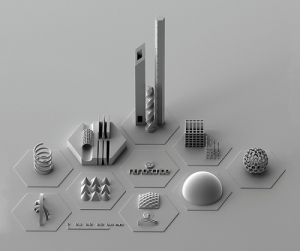
The versatility sample impressively illustrates the capabilities of Photonic Professional systems in 3D Microfabrication.
German company Nanoscribe, which manufactures and supplies high-resolution 3D printers for the nanoscale and microscale, is showing the world how its systems can up many opportunities in 3D microfabrication, with a new fly-over video, which truly highlights the design freedom it can offer when making 3D microparts with submicron features. The video shows actual scanning electron microscope (SEM) images of extreme filigree structures that were 3D printed on its Photonic Professional GT2.
From a variety of angles, you can see diverse geometries, which show off just how versatile Nanoscribe’s high-resolution 3D printing can be – all 18 of the objects and structures were printed in just over an hour. The company’s microfabrication technology makes it possible to create designs, like undercuts and curved shapes, and customizable topographies that would have been extremely difficult to do otherwise. To streamline the microfabrication process for its customers, Nanoscribe offers ready-to-use Solution Sets for its Photonic Professional GT2 printers, which, according to the company, “are based on the most suitable combination of precision optics, a broad range of materials and sophisticated software recipes for specific applications and scales.”
Xact Metal Names Laser Lines New UK Reseller
 Pennsylvaniastartup Xact Metal welcomes Laser Lines – a total solutions provider of 3D printers and laser equipment – as a UK reseller for its metal 3D printers. These machines, which offer extremely compact footprints, are meant for customers in high-performance industries that require high-throughput and print speed, such as medical and aerospace. Laser Lines will immediately begin distributing the Xact Metal XM200C and XM200S systems, as well as the XM300C model once it becomes available next year.
Pennsylvaniastartup Xact Metal welcomes Laser Lines – a total solutions provider of 3D printers and laser equipment – as a UK reseller for its metal 3D printers. These machines, which offer extremely compact footprints, are meant for customers in high-performance industries that require high-throughput and print speed, such as medical and aerospace. Laser Lines will immediately begin distributing the Xact Metal XM200C and XM200S systems, as well as the XM300C model once it becomes available next year.
“We are delighted to be the chosen UK supplier for Xact Metal, whose metal printing systems are establishing new levels of price and performance. Making quality metal printing accessible requires innovation. Xact Metal’s printing technology is built on the patent-pending Xact Core – a high speed gantry system platform where light, simple mirrors move quickly and consistently above the powder-bed on an X-Y axis. It’s another step change for our industry and opens a whole range of exciting opportunities,” stated Mark Tyrtania, the Sales Director at Laser Lines.
Discuss these and other 3D printing topics at 3DPrintBoard.com or share your thoughts in the Facebook comments below.
Nanoscribe introduces Quantum X, a two-photon 3D printer for microoptics
3D printing news Sliced: Zortrax, Organovo Holdings, Laser Lines, Zenith Tecnica
Nanoscribe joins photonics and quantum research program MiLiQuant
Project Miliquant: Nanoscribe Participates in Collaboration Using 3D Printing in Quantum Technology Research
 Nanoscribe has been impressing us at the micro- and nano-level for years now in 3D printing, from their work with plasmonics to micro-optics and many other projects related to industrial microfabrication. Now, the German manufacturer is developing miniaturized, frequency- and power-stable diode lasers with other industry leaders, to include:
Nanoscribe has been impressing us at the micro- and nano-level for years now in 3D printing, from their work with plasmonics to micro-optics and many other projects related to industrial microfabrication. Now, the German manufacturer is developing miniaturized, frequency- and power-stable diode lasers with other industry leaders, to include:
The group has come together for the three-year Miliquant project, funded by Germany’s Federal Ministry of Education and Research (abbreviated as BMBF for the German Bundesministerium für Bildung und Forschung). This is meant to be a technological and innovative forum where the 3D printed components for light sources that the companies involved create will be used in quantum technology innovation, suitable for applications like medical diagnostics, autonomous driving, and imaging procedures like infrared microscopy of cells.
Their goal is to work on multiple experiments in the lab for developing sensors and imaging systems primarily for industrial use. Complex research and development efforts will be required to develop robust components—along with new approaches for assembly and manufacturing—leading to the assembly of such a dynamic group that will work together with a common goal.
“With our 3D printers, high-precision micro-optical components can be produced in shortest time with submicrometer resolution and enormous design freedom,” said Dr. Michael Thiel, Chief Science Officer at Nanoscribe. “We are happy to contribute our profound know-how to the MiLiQuant project for the further development of packaging technologies.”
Using two-photon polymerization (2PP), the Nanoscribe team can 3D print parts and prototypes with exceptionally high performance and accuracy, and complex optical designs can be fabricated directly on components like laser facets, glass fibers, and microchips.
“The printed structures achieve an optical quality with surface roughness in the range of a few nanometers,” states the Nanoscribe team in their most recent press release regarding the multi-collaboration for their latest venture. “In the MiLiQuant project, the printed components will be assembled with other elements into a compact package.”
Nanoscribe has been contributing to the world of technology since 2007, born from a team of researchers at Karlsruhe Institute of Technology (KIT) determined to transform the budding science of microfabrication. Delving into what was originally an extremely niche realm of research, they began expanding the study of two-photon polymerization (2PP)—and setting the foundation for the German-headquartered Nanoscribe into motion.
As the budding technological team saw the vast potential for 2PP-based 3D printers and other wares, they made them available to companies around the globe, along with 3D software solutions, 3D printing materials, and a range of accompanying processes to provide comprehensive solutions. Nanoscribe currently employs 60 team members, also operating a subsidiary in Shanghai with future plans or creating one in the US too. Nanoscribe 3D printers are used on the micro-, nano-, and meso-scale for design and fabrication of components used in many different scientific applications today.
What do you think of this news? Let us know your thoughts! Join the discussion of this and other 3D printing topics at 3DPrintBoard.com.
[Source: Nanoscribe]

